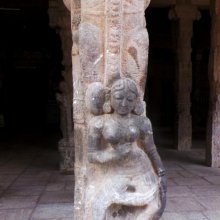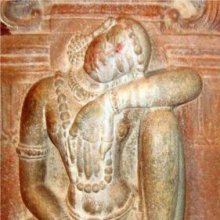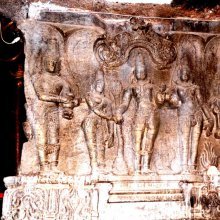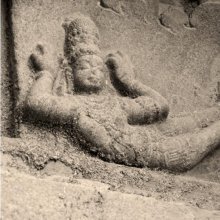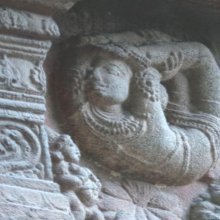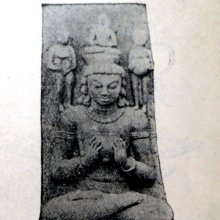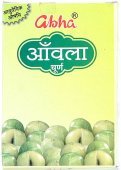Stomach: 2 definitions
Introduction:
Stomach means something in Hinduism, Sanskrit. If you want to know the exact meaning, history, etymology or English translation of this term then check out the descriptions on this page. Add your comment or reference to a book if you want to contribute to this summary article.
Images (photo gallery)
In Hinduism
Natyashastra (theatrics and dramaturgy)
Source: Shodhganga: Elements of Art and Architecture in the Trtiyakhanda of the Visnudharmottarapurana (natya)Showing the Stomach is associated with Karkaṭahasta: one of the thirteen Combined-hand Gestures (in Indian Dramas) (known as saṃyuktahastas), according to the Viṣṇudharmottarapurāṇa, an ancient Sanskrit text which (being encyclopedic in nature) deals with a variety of cultural topics such as arts, architecture, music, grammar and astronomy.—According to the Śabdakalpadruma, karkaṭa means kulira i.e., crab. In karkaṭahasta, fingers are passed between the fingers of both hands together and it makes the shape of a crab. This posture is used while yawning. According to Abhinayadarpaṇa, this karkaṭa-hasta is used to denote coming of a crowd, showing the stomach, filling the conch-shell, twisting limbs, pulling branch etc.

Natyashastra (नाट्यशास्त्र, nāṭyaśāstra) refers to both the ancient Indian tradition (shastra) of performing arts, (natya—theatrics, drama, dance, music), as well as the name of a Sanskrit work dealing with these subjects. It also teaches the rules for composing Dramatic plays (nataka), construction and performance of Theater, and Poetic works (kavya).
Yoga (school of philosophy)
Source: ORA: Amanaska (king of all yogas): A Critical Edition and Annotated Translation by Jason BirchThe Stomach is known in Sanskrit as Udara, and is various Yogic exercises, according to the Dattātreyayogaśāstra verse 35-38ab.—Accordingly, while describing the lotus pose (padmāsana): “[...] Having lifted the uvula with the tongue; having fixed the chin on the chest and having drawn in the breath slowly according to his capacity, he should fill [the region of] the stomach (udara). After that, he should exhale the breath slowly according to his capacity. This is said to be padmāsana, which destroys all diseases”.

Yoga is originally considered a branch of Hindu philosophy (astika), but both ancient and modern Yoga combine the physical, mental and spiritual. Yoga teaches various physical techniques also known as āsanas (postures), used for various purposes (eg., meditation, contemplation, relaxation).
See also (Relevant definitions)
Starts with: Stomach bush.
Full-text (+819): Jathara, Amasaya, Udara, Antarjathara, Amlapitta, Koshtha, Pakvashaya, Annashaya, Leliha, Malamali, Pakkashaya, Kakeruka, Hridvantaka, Gadavanem, Pupphula, Dagdhajathara, Udarapatala, Kukshiroga, Udar, Kothala.
Relevant text
Search found 204 books and stories containing Stomach; (plurals include: Stomaches). You can also click to the full overview containing English textual excerpts. Below are direct links for the most relevant articles:
Rasa Jala Nidhi, vol 4: Iatrochemistry (by Bhudeb Mookerjee)
Part 1 - Causes, symptoms, and indications of indigestion < [Chapter IV - Irregularity of the digesting heat]
Part 28 - Grahani (chronic diarrhea) < [Chapter III - Jvaratisara fever with diarrhoea]
Part 21 - Time for taking medicine < [Chapter I - General health prescriptions]
Charaka Samhita (English translation) (by Shree Gulabkunverba Ayurvedic Society)
Chapter 2 - The Measure of the Stomach Capacity (kukshi-vimana) < [Vimanasthana (Vimana Sthana) — Section on Measure]
Chapter 20 - The therapeutics of Vomiting (chardi-cikitsa) < [Cikitsasthana (Cikitsa Sthana) — Section on Therapeutics]
Chapter 20 - The Major List of Diseases (maharoga) < [Sutrasthana (Sutra Sthana) — General Principles]
Bhagavati-sutra (Viyaha-pannatti) (by K. C. Lalwani)
Part 9 - Prohibition regarding space etc. < [Chapter 1]
Tiruvaymoli (Thiruvaimozhi): English translation (by S. Satyamurthi Ayyangar)
Pasuram 7.4.4 < [Section 4 - Fourth Tiruvaymoli (Ali ela)]
Pasuram 3.7.10 < [Section 7 - Seventh Tiruvaymoli (Payilum Cutar oti)]
Pasuram 8.3.4 < [Section 3 - Third Tiruvaymoli (Ankum inkum)]
Mahabharata (English) (by Kisari Mohan Ganguli)
Section CCXC < [Mokshadharma Parva]
Section XVII < [Rajadharmanusasana Parva]
Section LXXVI < [Sambhava Parva]
Abhinaya-darpana (English) (by Ananda Coomaraswamy)
Related products
(+40 more products available)
